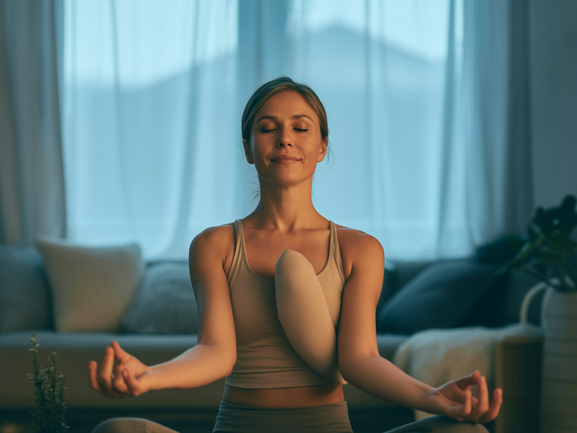What is the Luteal Phase? Understanding Your Menstrual Cycle and Finding Balance Through Yoga
Have you ever wondered what is the luteal phase and why you might feel more emotional, bloated, or tired during certain weeks of your menstrual cycle? You’re not alone in this journey of understanding your body’s natural rhythms.
The luteal phase is a crucial part of your menstrual cycle that affects not only your physical well-being but also your emotional state. Moreover, understanding this phase can empower you to work with your body rather than against it, especially through gentle practices like yoga and meditation.
Understanding the Luteal Phase: What Happens in Your Body
The luteal phase occurs after ovulation and lasts approximately 12-14 days, leading up to your next period. During this time, your body produces higher levels of progesterone, preparing the uterine lining for a potential pregnancy.
Furthermore, this hormonal shift creates a cascade of changes throughout your body. Your metabolism increases slightly, you may retain more water, and your mood can become more sensitive to external stressors.
“The luteal phase is like your body’s monthly reset button – understanding it helps you honor your natural rhythms.” – Vitalizen yoga instructors
Common Luteal Phase Symptoms: What to Expect
Recognizing luteal phase symptoms can help you prepare and respond more mindfully. Additionally, knowing these are normal experiences can reduce anxiety about these changes.
- Physical symptoms: Bloating, breast tenderness, headaches, food cravings
- Emotional changes: Mood swings, increased sensitivity, anxiety, or irritability
- Energy levels: Fatigue, need for more rest, decreased motivation for intense exercise
- Sleep patterns: Difficulty falling asleep or staying asleep
How Yoga Supports Your Luteal Phase Journey
Practicing yoga for menstrual cycle support, particularly during the luteal phase, can significantly improve your comfort and well-being. However, the key is choosing gentle, restorative practices rather than intense flows.
Yoga helps regulate your nervous system, which in turn supports hormonal balance and provides natural PMS relief. Additionally, mindful movement encourages better circulation and reduces inflammation.
Best Yoga Poses for the Luteal Phase
1. Child’s Pose (Balasana)
This nurturing pose helps calm your nervous system and provides gentle compression for your lower belly, which can ease cramping and bloating.
2. Legs-Up-the-Wall Pose (Viparita Karani)
Perfect for reducing swelling in your legs and feet while promoting relaxation. Moreover, this inversion helps regulate your hormones naturally.
3. Supine Spinal Twist
Gentle twists aid digestion and can help alleviate the bloating common during this phase. Furthermore, they release tension in your lower back.
4. Supported Bridge Pose
This restorative backbend opens your heart space while providing gentle stimulation to your reproductive organs, supporting healthy hormone production.
Learn more gentle poses and sequences specifically designed for your cycle with expert-led classes at Vitalizen.
Self-Care Tips for Your Luteal Phase
Beyond yoga, there are several ways to support yourself during this phase:
- Nutrition: Focus on complex carbohydrates and magnesium-rich foods
- Hydration: Drink plenty of water to help reduce bloating
- Sleep: Prioritize 7-9 hours of quality rest
- Stress management: Practice meditation and deep breathing exercises
- Gentle movement: Choose walking, stretching, or restorative yoga over high-intensity workouts
For guided meditation sessions specifically designed for hormonal balance, explore the comprehensive wellness resources available on our platform.
Frequently Asked Questions About the Luteal Phase
What exactly happens in your body during the luteal phase?
During the luteal phase, your body produces high levels of progesterone and estrogen. This hormonal surge prepares your uterine lining for potential implantation. If pregnancy doesn’t occur, hormone levels drop, triggering menstruation.
Why do I feel more sensitive during this time?
Progesterone has a calming effect on the brain, but as levels fluctuate, you may experience mood swings. Additionally, your brain’s sensitivity to stress hormones increases during this phase.
What types of exercise are best during the luteal phase?
Gentle, restorative activities work best. This includes yin yoga, walking, swimming, or light strength training. Avoid high-intensity workouts that might increase stress on your already fluctuating hormones.
How can yoga specifically help with PMS symptoms?
Yoga reduces cortisol levels, improves circulation, and activates the parasympathetic nervous system. This combination helps alleviate physical discomfort, reduces anxiety, and promotes better sleep quality.
Creating Harmony with Your Natural Rhythms
Understanding what is the luteal phase is just the beginning of developing a deeper connection with your body’s wisdom. When you align your lifestyle, exercise routine, and self-care practices with your natural cycles, you experience greater ease and vitality.
Remember, every woman’s experience is unique. Therefore, it’s important to listen to your body and adjust your practices accordingly. Some days you might feel energized for gentle yoga, while others call for pure rest and meditation.
At Vitalizen, we understand these nuances and offer specialized classes led by instructors trained in hormonal yoga and cycle-syncing practices. Our platform provides the tools and guidance you need to support your body through every phase of your cycle.

